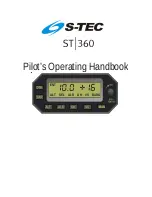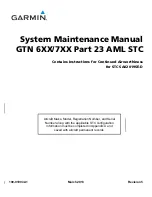
Page 31
Page 32
After changing the compensation direction, make sure to check it again on the actual model.
Self-check
Attentions
•
Before self-check, please place the model on the ground (level surface).
•
When the model is flying, aerodynamic balance is more important than level attitude, which results in that the model flys
at a constant altitude with the nose slightly pointing up at low speed. To avoid the nose-diving of the model at high air
speed, the user must ensure that the model is placed at a level or slightly-nose-up attitude during self-check.
•
Always install RB-30/RB-40 straight and level in the model. If required, PC software could be used to adjust the angle of
attack with the purpose of realizing the required setting. If the values set by the user is bigger than average ones, we
advise to recheck the installation orientation of RB-30/RB-40.
Steps
•
Turn on the transmitter and ensure that Ail (CH1), ELE (CH2), RUD (CH4), AIL 2(CH5) and ELE (CH6) are in the neutral
position.
•
Power on the model and start self-check. Ensure the auto level angle of the gyro and the neutral position of
gimbal. Please don’t touch/move the model until self-check finishes, or it may corrupt the calibration settings created during
the procedure.
•
Move the three-position sticks bound to CH12 three times in 3 seconds (up, mid, down). Then the BLUE LED will turn on,
indicating self-check procedure is initiated. After that, the corresponding parts on the model will move. At last, the BLUE
LED will turn off, indicating self-check has completed.
•
Move the sticks bound to CH1~CH6 (except the stick related to Thr) and check the channel output limits, ensuring that the
signal outputs of RB-30/RB-40 will not damage the corresponding parts on the model. In the end, RB-30/RB-40 will save
the zero points of the gyro, auto level angle, gimbal neutral position and servo channel limits.
•
Never operate the stick bound to CH12 during flight session or it will trigger self-check and may cause
the crash of the model.
•
Cut off the power supply of RB-30/RB-40, or self-check will fail.
Under identical operating conditions, the value of each channel is produced by the assigned switch in FrOS
are opposite to that in OpenTX. For exmaple, SW Up in FrOS is equal to SW Down in OpenTX.
Setup
•
Calibrate RB-30/RB-40 with the Lua.or Freelink App and install it into the model. Ensure the settings of wing type and
mounting type are identical to the intended model installation.
•
Turn on the transmitter and reduce the value of servo endpoint setting. Ensure self-check mode will not damage the
corresponding parts on the model.
•
Assign a knob/slider to CH9, then real-time gain adjustment capabilities of RB-30/RB-40 will be activated.
•
Assign three-position switches to CH10 and CH11 with the purpose of switching available flight modes.
•
Power on the model and check the deflection direction of each related parts on the model. Make sure the switch assigned
to flight modes is correct and the compensation direction of the gyro is set as intended on AIL, RUD and ELE.
•
Make a self-check for RB-30/RB-40 if necessary. Disconnecting the power on RB-30/RB-40 will not lose the set parameters.
01140167
Note: If the compensation direction is incorrect, you can reverse the corresponding channel with the Lua Script
(RB30/40 STAB Set 2/2) / FreeLink.

























